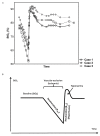Near infrared spectroscopy (NIRS) of the thenar eminence in anesthesia and intensive care
- PMID: 22569165
- PMCID: PMC3488540
- DOI: 10.1186/2110-5820-2-11
Near infrared spectroscopy (NIRS) of the thenar eminence in anesthesia and intensive care
Abstract
Near infrared spectroscopy of the thenar eminence (NIRSth) is a noninvasive bedside method for assessing tissue oxygenation. The NIRS probe emits light with several wavelengths in the 700- to 850-nm interval and measures the reflected light mainly from a predefined depth. Complex physical models then allow the measurement of the relative concentrations of oxy and deoxyhemoglobin, and thus tissue saturation (StO2), as well as an approximation of the tissue hemoglobin, given as tissue hemoglobin index.Here we review of current knowledge of the application of NIRSth in anesthesia and intensive care.We performed an analytical and descriptive review of the literature using the terms "near-infrared spectroscopy" combined with "anesthesia," "anesthesiology," "intensive care," "critical care," "sepsis," "bleeding," "hemorrhage," "surgery," and "trauma" with particular focus on all NIRS studies involving measurement at the thenar eminence.We found that NIRSth has been applied as clinical research tool to perform both static and dynamic assessment of StO2. Specifically, a vascular occlusion test (VOT) with a pressure cuff can be used to provide a dynamic assessment of the tissue oxygenation response to ischemia. StO2 changes during such induced ischemia-reperfusion yield information on oxygen consumption and microvasculatory reactivity. Some evidence suggests that StO2 during VOT can detect fluid responsiveness during surgery. In hypovolemic shock, StO2 can help to predict outcome, but not in septic shock. In contrast, NIRS parameters during VOT increase the diagnostic and prognostic accuracy in both hypovolemic and septic shock. Minimal data are available on static or dynamic StO2 used to guide therapy.Although the available data are promising, further studies are necessary before NIRSth can become part of routine clinical practice.
Figures
References
-
- Hungerer S, Nolte D, Botzlar A, Messmer K. Effects of Diaspirin Crosslinked Hemoglobin (DCLHb) on microcirculation and local tissue pO2of striated skin muscle following resuscitation from hemorrhagic shock. Artif Cell Blood Substit Biotechnol. 2006;34:455–471. doi: 10.1080/10731190600769008. - DOI - PubMed
-
- Trzeciak S, Dellinger RP, Parrillo JE, Guglielmi M, Bajaj J, Abate NL, Arnold RC, Colilla S, Zanotti S, Hollenberg SM. et al.Early microcirculatory perfusion derangements in patients with severe sepsis and septic shock: relationship to hemodynamics, oxygen transport, and survival. Ann Emerg Med. 2007;49:88–98. doi: 10.1016/j.annemergmed.2006.08.021. 98 e81-82. - DOI - PubMed
-
- Borchman D, Yappert MC, Herrell P. Structural characterization of human lens membrane lipid by infrared spectroscopy. Invest Ophthalmol Vis Sci. 1991;32:2404–2416. - PubMed
LinkOut - more resources
Full Text Sources
Other Literature Sources



